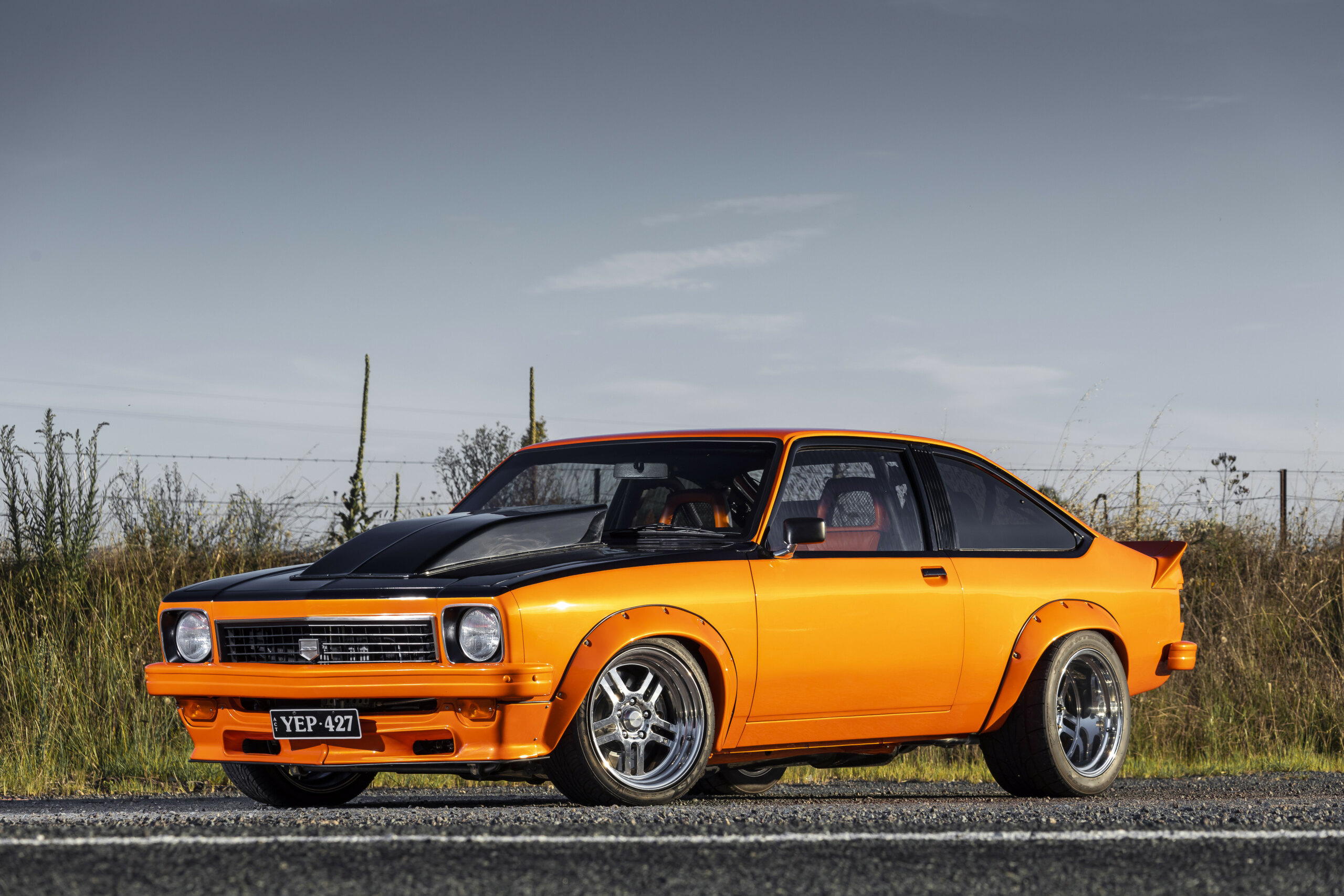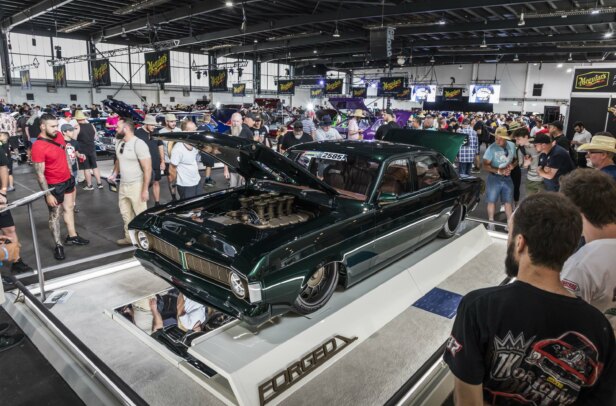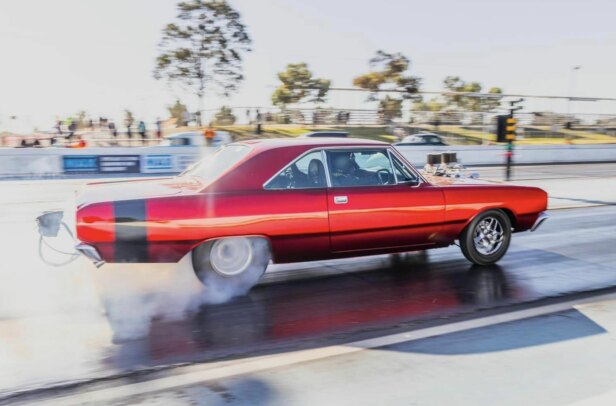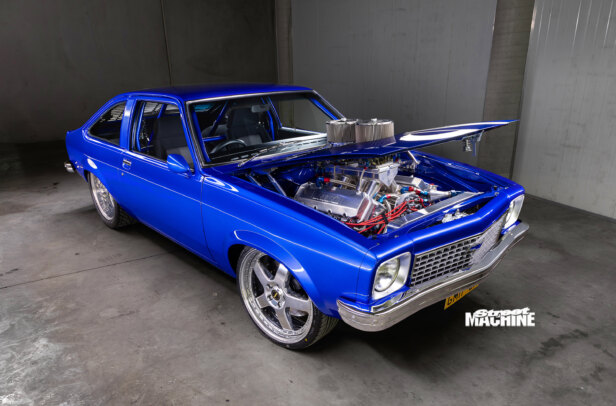Way back when VL Commodores were brand new, Farnsey had an epic mullet and Crocodile Dundee was showing off his weapon in New York, Canberra’s Brett Russell bought a very sad LX Torana hatchback. The young bloke had a thirst for speed, and he spent the next 36 years evolving it into the big-block Chevy-powered monster you see here.
First published in the May 2022 issue of Street Machine
“The Torana was a weekend race car that was due for the crusher,” he explains. “I found out it was for sale through word of mouth, so I went to have a look at it. Everything ahead of the firewall was gone and its entire floor was cut out, I think to get the diff mounting locations. There were no panels, and the only thing on it was the Panhard rod, which is still on the car.”
Young Brett’s original intentions for the trashed hatch were for a strip-pounding monster, but his local ACT drag strip was in the process of being shut down. This led to a rethink, which gave us one of the first street-legal, big block-powered hatchback Toranas.
“I got it for $500, and because Summernats was coming up, I decided to build a tough street car,” Brett says. “The firewall was 25cm back, so I pulled that out, unpicked the bits of the factory rails left, and then I got a front-cut from the wreckers to repair it. I decided to go full-chassis, which was all engineer-approved.”
This wasn’t a totally straightforward process, especially given that Brett was building the car in his home garage with the limited resources available in the era of hair metal. “The chassis was built out of 2mm-wall-thickness RSJ box, as that was all we could get,” he says. “It basically replaces most of the existing chassis except for the rails from the firewall forward, as they had to be retained for crumple zones. But I was allowed to slice the rails at 45 degrees – with reinforcement plates on top – for sparkplug and exhaust clearance.”
Once he had the framework sorted, it was time to party with some big-inch Heartbeat of America.
“Back in the day, if you wanted horsepower, you went cubes,” Brett reasons. “My friend Marcel had a four-door HJ in the mid-80s with a 454, and it went like stink. I went for a ride in that car just after I’d bought the shell, and I thought, ‘I’m not mucking around with a 308!’”
Originally equipped with a 427, then a 454, the LX currently runs an 800hp aftermarket Merlin X aluminium big-block swinging 427 cubes. The rotating assembly is based around a Scat 4340 crank and rods, with Ross slugs making 11.3:1 comp.
The Crane solid-roller cam adds womp with .750in lift and 275°/280° duration, playing on Comp Xtreme Energy lifters, 3 /8-inch pushrods and Manley valves and valve springs. Up top, the Brodix BB2 heads copped a five-axis CNC job from Westend Performance, while the tunnel ram is a custom unit from BG Engines, topped by a pair of Quick Fuel 750cfm four-barrel carbs.
“I had fuel injection on it, and I couldn’t get it to work properly, so I went back to carburettors,” Brett explains. “It had so much fuel wash I had to re-hone the bores and change to the new solid-roller cam while Westend did the heads. We got it running, but one of the lifter tie-bars let go and took out the cam on the way through.
“Because the engine is plate-mounted with rubber isolators, I can whip the sump and crossmember off without removing the headers, so I got it home and found the tie-bar,” he continues. “We were lucky the lifter didn’t spin in its bore, as I was told it would have been shot through the aluminium block!”
A big difference between Brett’s hatch and most fatty-equipped streeters sits behind the engine: a Centreforce clutch and Tremec T56 Magnum six-speed manual transmission!
“I love manuals; all my cars are manuals!” Brett enthuses. “It had a ’Glide for a while, but the auto almost hid the performance of the car; it was just always wheel-spinning. The manuals seem to put the power down and are more fun.”
A built nine-inch handles the difficult job of distributing all the big-block torque, while QA1 adjustable dampers and adjustable sway-bars sort the handling.
All the changes have made for a burly street car that Brett loves taking for a strap. “I’m super-happy with the performance; it slams you back in the seat!” he says.
“It’s a 30-plus-year build with four colour changes, multiple engine combos and interior styles,” he continues. “Every five to six years I’ve done an engine and paint colour change. I actually have another engine I’m going to start putting together soon.”
Not bad for a stacked shell that was headed for the shredder!
WEIGHT WATCHING
Alloy options for Chevy’s Mark IV big-block have existed all the way back to the late 60s with the factory’s mega-desirable, 427ci ZL1 option.
Iron was perfectly fine for the straight-line set, but not for Kiwi racing legend Bruce McLaren, who used the ZL1 with great success in the then-burgeoning Can-Am sports racing series. At the time, Can-Am was attracting all the top Formula One teams and drivers due to its incredibly lucrative prize money – and the fact that there were basically no rules on the size of the engine you could run in your featherweight, mid-engined tube-frame chassis.
Officially rated at 450hp, the ZL1 was only a carb, tune and header swap away from making 650hp. But the Can-Am teams soon started punching the cubes up to 496 and adding distinctive staggered mechanical injection trumpets to push that figure way up to 1000hp on the jungle-juice race fuel they ran.
Apart from the raw horsepower, the big attraction of the ZL1 for the circuit racing crew was its aluminium construction, which dropped the big-inch monsters down to approximately 260kg when dressed, compared to over 300kg for an iron mill.
Can-Am was all over by the mid-70s after Porsche brought 1200hp, twin-turbocharged flat-12s to a knife fight, so the aftermarket began picking up on lightweight big-block Chevys, offering them through companies like Donovan, World Industries, Dart and more.
BRETT RUSSELL
1977 HOLDEN LX TORANA SS HATCH
| Paint: | House of Kolor Tangelo |
|---|---|
| ENGINE | |
| Brand: | World Products Merlin X 427ci big-block |
| Induction: | BG Engines sheet-metal tunnel ram |
| Carbs: | Twin Quick Fuel 750cfm |
| Heads: | Brodix BB2+, CNC-ported |
| Camshaft: | Crane solid-roller 275/280, .750 lift |
| Conrods: | Scat 4340 |
| Pistons: | Ross |
| Crank: | Scat 4340 |
| Oil system: | Moroso billet oil pump, Stef’s alloy sump |
| Fuel system: | Holley Dominator pump |
| Cooling: | Ford Motorsport radiator, Spal fans |
| Exhaust: | Four-into-one 21/8in extractors, 3.5in system |
| Ignition: | MSD |
| TRANSMISSION | |
| Gearbox: | Tremec T56 Magnum |
| Clutch: | Centreforce DFX |
| Diff: | Strange Engineering alloy 9in, Sure-Grip centre, Moser axles, Strange pinion, billet yoke |
| SUSPENSION & BRAKES | |
| Front: | QA1 coil-overs, adjustable sway-bar |
| Rear: | QA1 shocks, adjustable Panhard bar, adjustable sway-bar |
| Brakes: | 330mm discs and two-piston calipers (f), 320mm discs and two-piston calipers (r) |
| Master cylinder: | CPP 11/8in |
| WHEELS & TYRES | |
| Rims: | Center Line billet, 17×9.5 (f), 17×11 (r) |
| Rubber: | Maxxis 245/50R17 (f), Nitto 315/35R17 (r) |
THANKS
My close friend Marcel for all his assistance over the years and with the current engine build; BG Engines for their help sourcing the alloy block, rotating assembly and machining, and making the manifold to a difficult request




Comments